Catan: Cities & Knights, formerly The Cities and Knights of Catan, is an expansion to the board game The Settlers of Catan for three to four players. It contains features taken from The Settlers of Catan, with emphasis on city development and the use of knights, which are used as a method of attacking other players as well as helping opponents defend Catan against a common foe. Cities & Knights can also be combined with the Catan: Seafarers expansion or with Catan: Traders & Barbarians scenarios.

Catan: Seafarers, or Seafarers of Catan in older editions, is an expansion of the board game Catan for three to four players. The main feature of this expansion is the addition of ships, gold fields, and the pirate to the game, allowing play between multiple islands. The expansion also provides numerous scenarios, some of which have custom rules. The Seafarers rules and scenarios are also, for the most part, compatible with Catan: Cities & Knights and Catan: Traders & Barbarians.
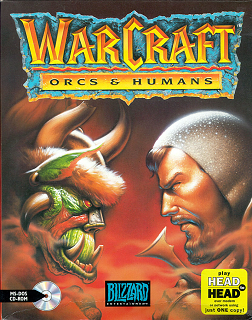
Warcraft: Orcs & Humans is a real-time strategy game (RTS) developed and published by Blizzard Entertainment, and published by Interplay Productions in Europe. It was released for MS-DOS in North America on 15 November 1994, and for Mac OS in early 1996. The MS-DOS version was re-released by Sold-Out Software in 2002.
In tabletop games and video games, game mechanics are the rules or ludemes that govern and guide the player's actions, as well as the game's response to them. A rule is an instruction on how to play, a ludeme is an element of play like the L-shaped move of the knight in chess. A game's mechanics thus effectively specify how the game will work for the people who play it.
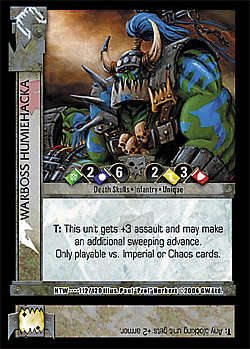
Dark Millennium is an out-of-print collectible card game. It's the successor to the Horus Heresy and set in the fictional Warhammer 40,000 universe. The base card set was launched in October 2005 by Sabertooth Games.
StarCraft: The Board Game, published by Fantasy Flight Games, is a game inspired by the 1998 computer game StarCraft. Players take control of the three distinctive races featured in the video games, the Terrans, the Protoss, or the Zerg, to engage in battle across multiple worlds in order to achieve victory. Each of the three races features a fairly different playing style. A prototype of the game was shown in BlizzCon 2007, with pre-release copies sold at Gen Con 2007 and Penny Arcade Expo 2007. It was publicly released in October 2007.

Settlers of Canaan is a multiplayer board game which is an adaptation of Catan and includes themes from the Hebrew Bible. It was published in 2002 by Cactus Game Design, based in North Carolina.
Storm Over Arnhem is a 1981 board wargame designed by Courtney F. Allen, published by the Avalon Hill game company, and depicts the battle for Arnhem bridge over the Lower Rhine river during Operation Market Garden in World War II. This battle was fought between elements of the British 1st Airborne Division and elements of the German Bocholt Battalion and 9th and 10th SS Panzer Divisions. The plan was for the airborne forces to seize and hold the Arnhem bridge for two days, before being relieved by the British XXX Corps. However, Operation Market Garden failed in numerous places, and the airborne troops were never relieved. They did however achieve more than their objective by capturing and holding the northern end of the Arnhem Bridge with some 700+ men for four days.

Starship Catan is a two-player card game, loosely based on the Starfarers of Catan board game. As a member of the Catan family of games, it is designed by Klaus Teuber, and distributed by Kosmos in German and Mayfair Games in English.

Starfarers of Catan is a multiplayer board game loosely based on the Settlers of Catan series of games. It was created by Klaus Teuber as an official spin-off and is distributed by Kosmos in German and Mayfair Games in English.
The Catan Card Game, originally named The Settlers of Catan: The Card Game, is a card-game adaptation of The Settlers of Catan board game. It is a member of the Catan series of games developed by Klaus Teuber and published by Kosmos in German, and by Mayfair Games in English. The Catan Card Game is a two-player game, although the rules can be accommodated as to allow players to share a set or for each player to have their own, as is intended for tournament play. Seven expansions of the Catan Card Game have also been released.
Catan Histories: Struggle for Rome is a 2006 German-style board game based on the game mechanics of Settlers of Catan, depicting the fall of the Western Roman Empire. The game is created by Klaus Teuber, the creator of Settlers, and is published under license from Catan GmbH by Kosmos in German and Mayfair Games in English. It is the second game in the Catan Histories series of board games. Often games produced in different languages by different publishers have slight rule differences between the versions. Catan Histories: Struggle for Rome is no exception.
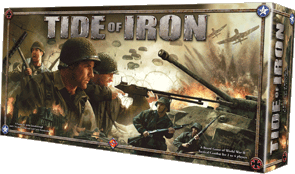
Tide of Iron is a World War II based wargame designed and published in 2007 by Fantasy Flight Games, also notable for publishing other large games containing a large number of counters and/or other components such as World of Warcraft: The Board Game and Arkham Horror.
Catan: Traders & Barbarians is the third expansion to the Settlers of Catan games, developed by Klaus Teuber. It contains a series of new scenarios and small variations, which are meant for two, three, or four players, with limited compatibility between the other two expansions, Catan: Seafarers and Catan: Cities & Knights. Three of the modules had been previously offered as "mini-expansions", though two have new rules in Traders. The expansion itself is named for one of the scenarios therein.
Catan Historical Scenarios II: Troy and Great Wall is the second Historical Scenario expansion to the Settlers of Catan game, released in 2001 by Kosmos, though other distributors have redistributed this with a rules translation. Both scenarios are designed for four or six players; six-player play requires the Settlers 5-6 player extension.

Age of Mythology: The Boardgame is a board game created by Glenn Drover based on the video game Age of Mythology. It was released in 2003 by Eagle Games. Up to four players may play the game, but extra parts may be purchased from Eagle Games to allow eight players to play.
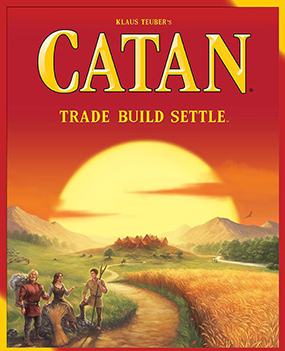
Catan, previously known as The Settlers of Catan or simply Settlers, is a multiplayer board game designed by Klaus Teuber. It was first published in 1995 in Germany by Franckh-Kosmos Verlag (Kosmos) as Die Siedler von Catan. Players take on the roles of settlers, each attempting to build and develop holdings while trading and acquiring resources. Players gain victory points as their settlements grow and the first to reach a set number of victory points, typically 10, wins. The game and its many expansions are also published by Catan Studio, Filosofia, GP, Inc., 999 Games, Κάισσα (Káissa), and Devir. Upon its release, The Settlers of Catan became one of the first Eurogames to achieve popularity outside Europe. As of 2020, more than 32 million copies in 40 languages had been sold.
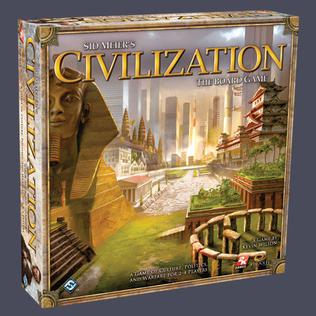
Sid Meier's Civilization: The Board Game is a 2010 board game created by Kevin Wilson based on the Sid Meier's Civilization series of video games and published by Fantasy Flight Games. While the previous board game based on Sid Meier's Civilization, published by Eagle Games in 2002, was based on Civilization III, the 2010 version takes its primary inspiration from Civilization IV. Its expansions, Fame and Fortune and Wisdom and Warfare, also began to incorporate concepts derived from Civilization V.

Armageddon: Tactical Combat, 3000-500 BC is a board wargame first published by Simulations Publications Inc. (SPI) in 1972 in Strategy & Tactics, then released as a stand-alone game, then reimplemented as Chariot: Tactical Warfare in the "Biblical" Age, 3000-500 BC.

The BattleTech Trading Card Game is an out-of-print collectible card game (CCG) set in the BattleTech universe. The game was developed by Wizards of the Coast (WotC) for FASA and released in 1996.












